“Art acts as cultural radar, an early alarm system for the development of media.” - Marshall McLuhan, Understanding Media
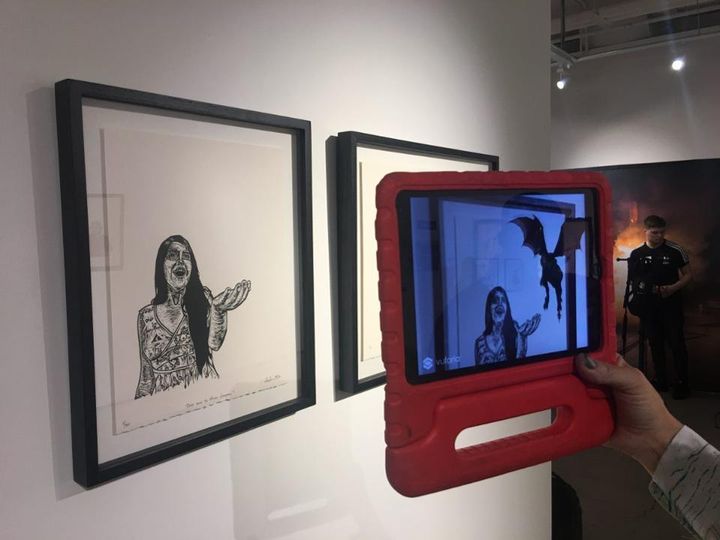
Zenka's AR artwork at Art of VR, presented by The VR Society at Sotheby's New York, June 22-23, 2017.
This post was originally featured on Forbes.com on July 11, 2017
The development of Augmented and Virtual Reality (often referred to as Mixed Reality) is still in the “tools” stage. There isn’t much in the way of content, as the tools to create those experiences are just reaching the hands of artists who make the magic. Apple just released its SDK (Software Developer Kit) for ARKit, a technology that will accompany the release of the iPhone 8 and iOs 11 in the fall. AR today is primitive. Snapchat Filters and Pokemon Go are its best-known applications. VR, meanwhile, is dominated by primitive systems Google Cardboard and Samsung GearVR (they represent about 75% of consumer VR devices), whose principal content is low-resolution 360 videos.
Within these limitations, artists are using the tools at hand to create compelling experiences which foreshadow the enhanced digital world about to unfold. The VR Society, a non-profit organization created by major Hollywood studios and top technology companies to advance the arts of VR and AR recently presented The Art of AR at Sotheby’s New York, June 22 & 23rd. The two-day conference featured technology demonstrations, experiences, and entertainment exhibits spread across several floors of galleries. Upstairs, the VR Society presented panels in the main hall where sheiks and moguls bid ten of millions for the world’s most sought after 2D art. Here’s the thing that struck me: art and technology were the most interesting part. The commercial applications, which included a VR experiences based on the “Alien” and “Spiderman” movies were less exciting. It is great to see big media companies investing in this new medium, but their goal is hardly art, it’s the expansion of their most important franchises. By the way, the value of movie franchises to Virtual Reality cannot be understated. People know what to do there.
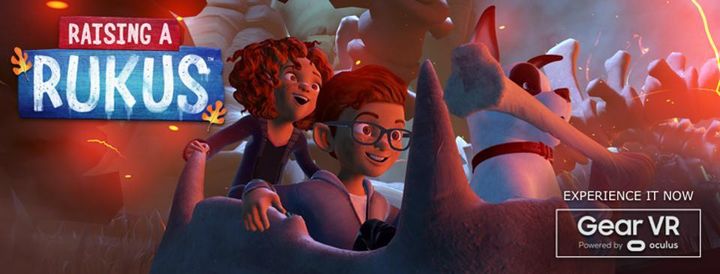
“Raising A Ruckus” is available in the Oculus Store for the Rift and GearVR.
The Virtual Reality Company (VRC), a content studio and production company founded in 2014 by Hollywood veterans including two-time Oscar winner Robert Stromberg (Production Design on “Avatar”), who directed “The Martian VR Experience” for 20th Century Fox Innovation Labs last year. VRC occupied a large gallery which they filled with production art and a dozen seated VR stations to present its newest immersive production, a beautifully animated short, “Raising a Ruckus”, $3.99 in the Oculus store. You have great presence inside the world of the narrative, though no agency to move or affect the action yourself. You’re the camera on a roller coaster ride of tracking shots and swirling effects. “We are in the early days of unlocking the power of this new medium,” said Stromberg. “It’s similar to my time working on Avatar, VRC is in a constant state of invention and innovation, testing and pushing the artistic, storytelling and technical potential of VR.” The company recently announced a partnership with IMAX to make “Raising a Ruckus” available at its IMAX VR centers in LA, and New York City.
Perhaps the most interesting work came from 2D artists using new media to digitally augment their physical work. Watch below as VR artist, sculptor and printmaker Zenka lifts her pad in front of her lino prints and releases their hidden digital enhancements. You can do this, too. Simply install the free app, then point your camera at one of Zenka’s prints online. The prints themselves are the triggers.
Jane Lafarge Hamill is best known for her abstract oil paintings. She’s represented by prestigious New York art gallery FMLY. Lately, she’s been working in virtual reality, and not for money, or marketing, or fame, or any mundane reason. “I simply want to walk into one of my paintings,” Hamill says. The viewer’s entry begins before they even put on the headset, by facing the physical paintings across the room. Then, headset on, they see a scan of the same piece at the same size. “It’s important to me that the viewer begins with a real object; having the actual painting there before they put the headset on and see its simulacra, is a subtle but integral part. This grounds it in Reality.” The viewer then walks through the surface of the painting, which deconstructs around you.
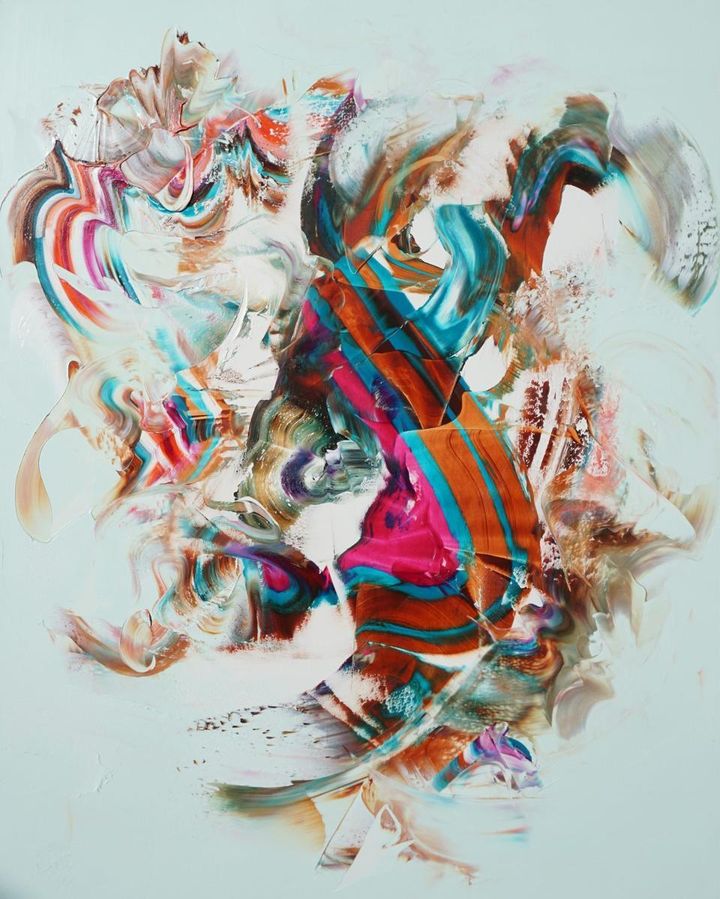
Jane Hamill’s VR piece “Wavering Calm” lets you walk inside her painting.
A friend gave Hamill a crash course in Unity. “It’s a steep learning curve, and I’ve only brushed the surface.” This tells us two things. First, you can create meaningful content on Unity even if you only have an art degree and, most importantly *holy crap* artists like Hammil are going to change the way think about this new media.
Kevin Mack is an artist and visual effects pioneer who won an Oscar for his effects work on the movie “What Dreams May Come”. Mack has been nursing visions for immersive virtual reality art experiences for decades. At Sotheby’s he was exhibiting his constantly evolving VR world, “Blortasia”, which allows users to float or jet through a seemingly organic, ever-evolving lava lamp like environment. The experience is trippy, relaxing, weightless, and disorienting. All at the same time. I made a note to find it on Steam so I can do it some more. “The potential of virtual reality as an art form is mind boggling. I’ve always dreamed of using technology to transport people to places and experiences beyond imagination. Virtual reality is making my lifelong dream an actual reality.”
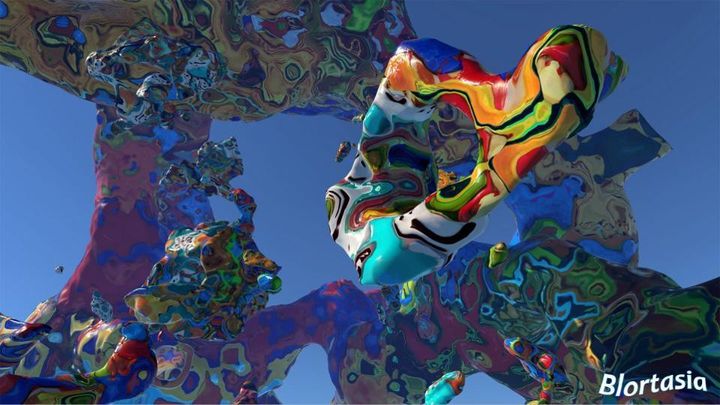
Blortasia, an abstract immersive virtual world by Academy Award winning VFX artist Kevin Mack.
Virtual Reality galleries within the gallery were the subject of several exhibits. Notably, The Apollo Museum and the Harold Lloyd Stereoscopic Museum, were both built using Linden Lab new VR platform, Sansar. which is still in closed beta. Linden created and operates the insanely profitable 3D social world Second Life. Bjorn Laurin, VP of Linden Labs, told me Sansar will be the WordPress of VR, a simple world construction tool and platform that anyone can use to create their own VR world. In the Apollo Museum, visitors are greeted by a holographic Buzz Aldrin and can walk alongside a full-size model of the Saturn V rocket. Silent movie legend Harold Lloyd was enamored with stereographic photography for decades and took thousands of 3D photos of celebrities like Marilyn Monroe, and events like the opening of Disneyland. Lloyd’s photos and other memorabilia from his long career have been lovingly curated by his granddaughter and placed in a VR museum that allows you to navigate as if in a real building.
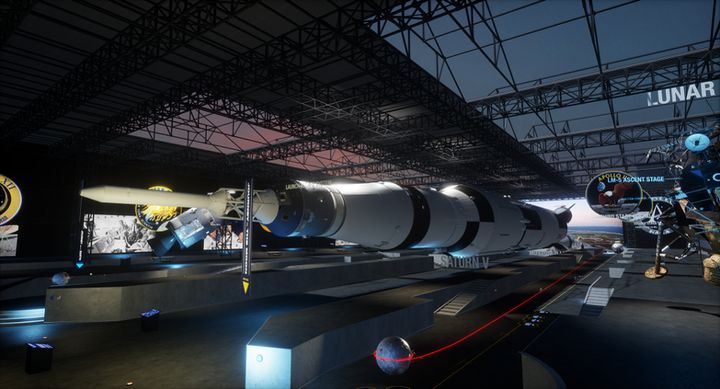
Apollo VR Museum created by LOOT Interactive using Linden Labs new Sansar VR platform.
VR and AR art will hardly be confined to galleries, and ultimately will be integrated into many of the things we view casually every day, like entertainment, advertising, sports, and medicine. Even theater, among the most ancient arts, is embracing this new medium. England’s Royal Shakespeare Company’s recent production of “The Tempest” featured a digital Ariel created using an on-stage actor in a motion capture suit. Arena Stage of Washington, D.C., an important national institution, announced last week its new artist-in-residence is Patty Rangel. Rangel holds a Master of Fine Arts in Theater Producing (Design & Production program) from CalArts and is an alumnus of the GSP program in Exponential Technologies from Singularity University at NASA Ames. Rangel will spend months at a time at Arena Stage, infusing new technology in every aspect of production: design, lighting, story development, even acting. Rangel told me “theater needs to be in the conversation.”
“Across the board, the feedback from the participants and guests [at Sotheby’s] was extremely positive. Our youngest guest was 5, our oldest was 97. We saw significant attendance by students and young people and the Artists we welcomed are already working on their next projects in VR and AR. So this is a rapidly advancing conversation and we’ll stage the event again next year.” said Jim Chabin, president of The VR Society.
_________________________________________________________
Charlie Fink is a former Disney, AOL and AG Interactive executive who writes about VR, AR and new media. In the 90s he was EVP & COO of VR pioneer Virtual World Entertainment. Linkedin
